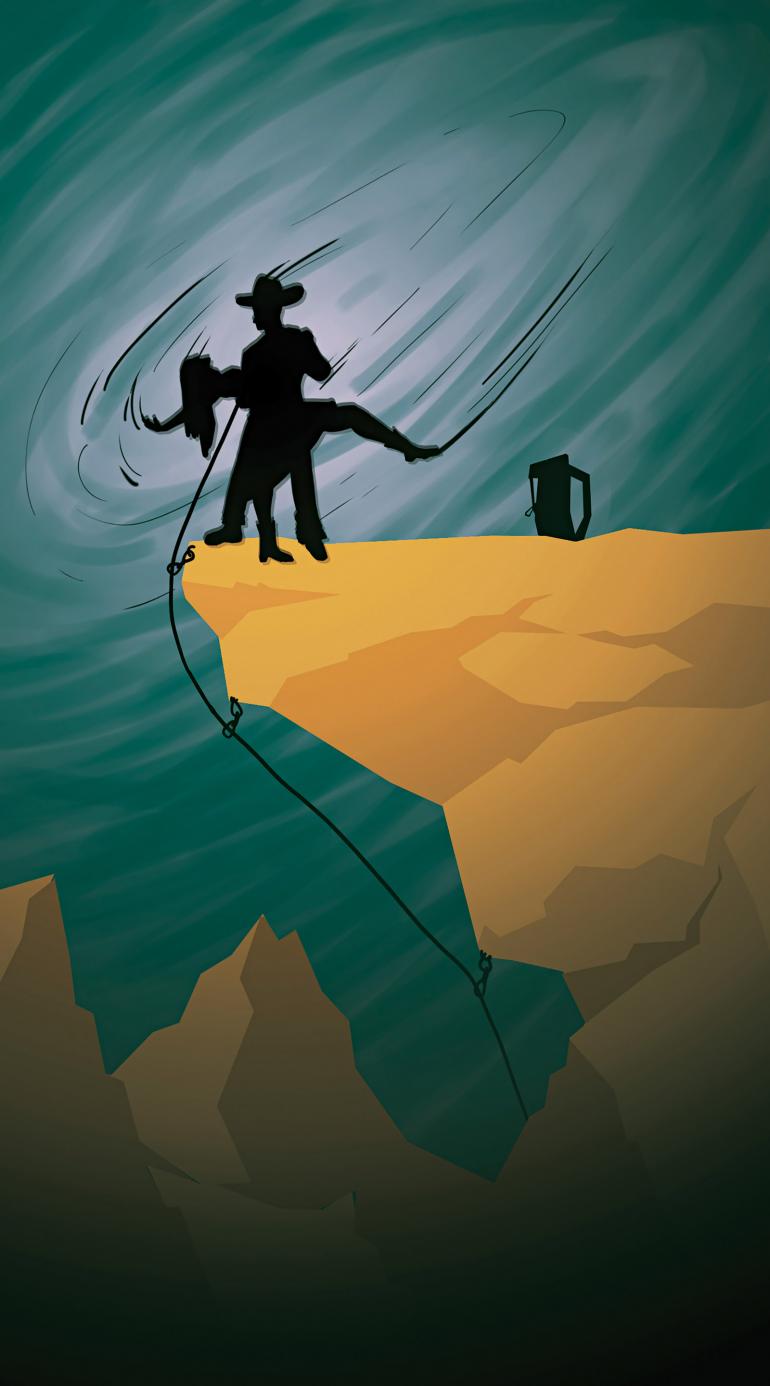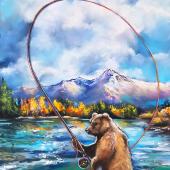Chalk on My Boots
An unlikely cultural overlap in the Bozone.
My body twirls in the crowded space, bumping into sweaty flesh as I pivot around my partner. He pulls me back close to his chest, then pushes me out again with just the force of his hands.
We’ve been practicing these moves for weeks. I finally know the steps well enough to slide gracefully through the room, though I sometimes stumble over unanticipated movements. As a woman, I am not supposed to lead my partner, but I struggle to relinquish control. The steps move directly into the spins, which move directly into the dips, and if we are lucky, the jumps. When it all comes together it feels like we’re floating—our feet barely touching the ground as we effortlessly create something beautiful. When it doesn’t work, it feels as though I could slam to the floor at any moment, all momentum lost to the hardwood planks.
I began to understand that the teamwork of swing dancing was not just a matter of me surrendering control of my body to another—it was the art of learning how to work together.
I admittedly wasn’t much of a dancer when I first started out. I spent most of my free time climbing, a sport where I was in control of my own movements and the placement of my own body. Just my hands, feet, and the stationary rock wall. Swing dancing, however, was impossible to do without relying on another to make progress. It took two individuals, and forced them to move as one.
I learned to swing dance at the Jump with a couple of my climbing friends. I was surprised by how many people knew the steps as though they were born on the dance floor. Cowboy boots covered the floor. The space was a jumble of bodies moving to and fro, bumping into each other and pushing into rapid spins. It was a chaotic scene that seemed somehow choreographed. Dozens of people all understood what to do when the music played; no one seemed to need much explanation.
I started attending lessons. Soon the dance seemed less foreign to me, and I became one of the women twirling in my thrift-shop cowboy boots. I began to understand that the teamwork of swing dancing was not just a matter of me surrendering control of my body to another—it was the art of learning how to work together. If my partner dipped me, I needed to fall back into his arms trustfully, but he also needed to trust that I would control my torso, and that I would follow him into that dip. In that way, I found that swing dancing was similar to climbing after all. It was tossing of control from one to another that neither of us could do alone.
The sport was a puzzle of movements, and I fit the pieces together as I pulled and stepped my way to the top: a delicate foot placement near my hip, followed by a strong pull-up to the next series of varied holds.
At some point, I made the shift from lessons at the Jump to late-night open dance at the R-Bar. I never expected to step foot in that college bar on a weeknight, but there I was—mingling with the most mismatched group of people I had ever seen in Bozeman.
It was a unique overlap of the sub-cultures in town. I typically arrived with a group of my climber buddies, but I’d inevitably end up dancing with college students, construction workers, and native Montanans who grew up wearing cowboy hats and ranching with their dads. I had always known that Bozeman contained a collision of many different cultures, political views, personalities, and upbringings, but it never felt as though my fellow transplant-outdoorsy-liberals and I would ever interact much with the Bozeman-bred, blue-collar, more conservative crowd. R-Bar on a Wednesday night, however, proved me wrong.
One of my first dance partners and I would often spend post-work afternoons climbing outside or at the gym. At a crag, he would attach himself to one end of the rope as I floated my way up the rock. The sport was a puzzle of movements, and I fit the pieces together as I pulled and stepped my way to the top: a delicate foot placement near my hip, followed by a strong pull-up to the next series of varied holds. Though he could not control my movements, he was there to react and respond—to keep the rope tight or catch my falls.
But still I wondered, what brought others into this space? Was it the music? The connection to western culture? The hope that one’s future romantic companion could also be spinning around in the crowd?
Afterward, we would offer our IDs to the bouncers at the bar, and transition from gliding up the wall to sliding across the dance floor. Our bodies moved together in similar ways. Though we were not connected by a rope, we were reliant on each other to perform the steps. He would hand me a piece of the puzzle by grabbing my hand and pushing me out into a spin, and I would take that piece and connect it to the rest. He was there to support me physically, so that I did not hit the floor, and mentally, so that we could maintain an image of grace and competence together. We had to match each other in steps and in thought.
It felt like both sport and art—just like climbing. And true to both, I could not just flounder my way across the dance floor and expect anything to come of it. I realized that my growing appreciation for swing dancing mirrored my love for climbing. The beauty of the steps came from focus, body-awareness, intention, and strength.
But still I wondered, what brought others into this space? Was it the music? The connection to western culture? The hope that one’s future romantic companion could also be spinning around in the crowd? Was it the line dances where folks could show off their Footloose steps? Or was it the desire to connect with people from all corners of this small Montana community, regardless of beliefs, backgrounds, or dreams? I don’t have answers, but every now and then I get little glimpses as I twirl and prance across the floor.
A cowboy who looks to be around my age, maybe a bit younger, approaches me with a huge smile. “Care to dance?” he asks.
I’m a bit hesitant. I don’t know if I can match his pace, or if he’s going to hit on me for the full duration of a song. Still, I take his hand and follow him onto the floor. We spin easily and I replicate moves that I’ve used with my more-familiar partners. His skills surpass mine by a mile—he seems to be one of those Montana boys who learned swing dancing as a school extracurricular—but he’s patient with my missteps, and walks me through a couple of new moves. By the end, we were both laughing and spinning in sync. When the song stops, he thanks me and continues on to the next woman.
I am relieved when he slips away, but I realize that I don’t need to be. That’s not what swing dancing is about. The interaction was never meant to be romantic—he wasn’t luring me onto the floor as a way to initiate a night together. Just like climbing, swing dancing is about the grace and flow of two bodies moving in reaction to each other, and the beauty that this creates. Above all, though, it is about a fun, sincere interaction between two people—in this case two strangers—and the enjoyment that they can share in this one brief moment together.













